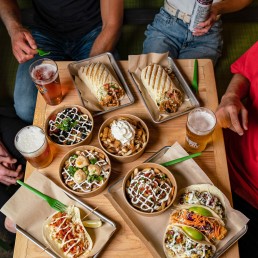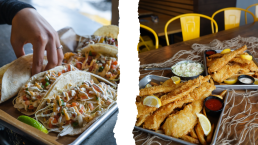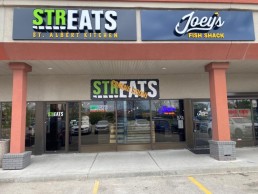Expanding Horizons: Marlborough Dual Restaurant



Two Beloved Brands, One Efficient Kitchen, Coming Soon to Marlborough, Calgary
OPENING AUGUST 28TH, 2023
150 52 St NE #10, Calgary, AB
The culinary scene in Marlborough, Calgary is about to get twice as exciting with the grand opening of a groundbreaking dual-location restaurant on August 28th. Nestled at 150 52 St NE #10, Calgary, AB T2A 1X1, this innovative establishment promises to redefine dining experiences by offering the best of both worlds: strEATS and Joey’s Fish Shack, all under the same roof.
An Array of Flavors and Convenience
The concept of a dual-location restaurant may be novel, but its benefits are boundless. This ingenious approach is poised to deliver an array of advantages that are certain to tantalize the taste buds and delight every diner who walks through the doors.
Culinary Diversity in Every Bite
With strEATS and Joey’s Fish Shack side by side, patrons can now indulge in a wider range of culinary offerings. Craving our famous Fish Sandwich? No problem. Hankering for sizzling fusion tacos? You got it. Whether you’re in the mood for seafood delights or international street food flair, this dual-location setup has you covered, making it the perfect destination for groups with diverse cravings.
Distinct Brand Identity
By seamlessly blending two distinct restaurant concepts, the dual-location format promises an atmosphere that caters to various preferences. Whether you’re a fan of strEATS’ vibrant and bustling street food vibe or you prefer the cozy coastal charm of Joey’s Fish Shack, you can expect a dynamic environment where everyone feels at home. This dual restaurant means that our franchisees have the freedom to serve multiple demographics with often opposite tastes and preferences, without sacrificing any quality or ambiance. While it’s no secret that both brands are operating under the same kitchen, the customer experience is seamless and many patrons wont have any idea both restaurants are under the same ownership.
Efficiency Redefined
From a business perspective, operating two restaurant brands under a single roof provides exceptional efficiency. Shared infrastructure, including kitchens, utilities, and even staff resources, can result in reduced operational costs. This innovative strategy allows for more strategic allocation of resources, which ultimately benefits both the establishment and its patrons.
A Remarkable Journey of Growth
The excitement surrounding this new dual-location venture isn’t just about the culinary offerings; it’s a testament to the rapid growth and success that strEATS and Joey’s Fish Shack have achieved. The decision to expand into Marlborough, Calgary, reflects the undeniable popularity and demand for these beloved brands.
“We’re thrilled to embark on this new chapter of growth,” shares Micheal Klassen, Director of Brand Development at strEATS and Joey’s Fish Shack. “Our aim has always been to provide our patrons with extraordinary dining experiences, and this dual-location setup allows us to do just that while embracing innovation and efficiency.”
The journey that began with a passion for exceptional food has transformed into a remarkable success story, paving the way for future expansion and exciting culinary endeavors.
As August 28th approaches, anticipation mounts, promising the residents of Marlborough and visitors from all around Calgary an unparalleled dining adventure. The combination of strEATS’ global street food inspiration and Joey’s Fish Shack’s coastal charm is set to create memories and flavors that will linger long after the meal is over.
In a world where culinary possibilities are endless, strEATS and Joey’s Fish Shack stand as pioneers, proving that sometimes, the best way to delight food enthusiasts is by offering them not just one, but two exceptional dining experiences under a single, welcoming roof.
Embracing Dual Concepts with StrEATS and Joey's Fish Shack
Use a Dual Concept to Optomize Your Franchise Investment
In the dynamic world of food service, innovation is the key to success. We are thrilled to announce the successful opening of our new dual concept restaurant, where two distinct brands, StrEATS and Joey’s Fish Shack, have found a harmonious home under one roof. This pioneering approach allows us to cater to separate age demographics, reduce overhead costs, and introduce an exciting rebranding journey for Joey’s Fish Shack.
-
Lower Overhead, Higher Efficiency:
Combining two brands under the same kitchen significantly reduces overhead costs, a game-changing factor in the highly competitive restaurant industry. By sharing kitchen space and resources, we optimize operational efficiency without compromising on the quality and uniqueness of each brand’s offerings. This synergy enables us to focus on delivering exceptional dining experiences for both the younger crowd who love StrEATS and the older patrons who cherish Joey’s Fish Shack.
-
Tailoring to Different Age Demographics:
Understanding the diverse tastes and preferences of our customers, we carefully curated two distinct brands that cater to separate age demographics. StrEATS, the vibrant and trendy concept, appeals to the younger generation seeking adventurous flavors and exciting presentations. On the other hand, Joey’s Fish Shack, formerly known as Joeys Seafood, celebrates the rich tradition of seafood in a warm and inviting ambiance, attracting the more mature audience seeking classic favorites and a relaxing atmosphere.
-
Introducing StrEATS:
StrEATS welcomes diners to embark on a journey of global street food delights. From mouthwatering tacos bursting with international flavors to smash burgers that smash expectations, StrEATS promises an adventurous dining experience like no other. The colorful and contemporary dining room complements the eclectic menu, creating a vibrant ambiance that resonates with the younger crowd.
-
The Rebirth of Joey’s Fish Shack:
Undergoing a successful rebrand from Joeys Seafood to Joey’s Fish Shack was an exciting milestone for us. The transformation allowed us to refine and update the brand’s identity while preserving its reputation for delectable seafood dishes. With an emphasis on fresh, sustainably sourced seafood and a menu that celebrates coastal culinary traditions, Joey’s Fish Shack takes diners on a nostalgic journey by the sea.
-
Seamless Experience, Unique Offerings:
While both brands operate from the same kitchen, each brand’s dining room exudes a distinct personality and ambiance. We have meticulously designed each space to match the theme and vibe of the respective brand. The separation of dining areas ensures that diners can enjoy a seamless experience tailored to their preferences.
Conclusion:
The successful launch of our dual concept restaurant, StrEATS, and Joey’s Fish Shack, is a testament to the power of innovation, adaptability, and customer-centricity. By embracing this novel approach, we have not only reduced overhead costs but also delighted two different age demographics with unique culinary experiences. StrEATS appeals to the adventurous spirit of the younger crowd, while Joey’s Fish Shack continues to serve classic seafood dishes to our beloved mature patrons.
We are excited about the journey ahead and look forward to continuing to delight our guests with the vibrant flavors of StrEATS and the timeless charm of Joey’s Fish Shack. Come, join us on this gastronomic adventure, where the culinary worlds of two distinct brands collide in a harmonious and unforgettable union.
3 Pillars to a Successful Restaurant
What are the 3 Pillars of a successful restaurant?
Running a successful restaurant requires a combination of factors, including food quality, customer service, and the atmosphere of the space. Each of these factors plays a critical role in creating a memorable dining experience that keeps customers coming back. In this blog post, we'll explore these three main factors and why customer service is the most important.
These items are things that we all know intutivley but often forget about in the 'heat of the kitchen'. Buckle down and make sure you have all three of these facors down pact before you do anything else. A slip on one of these three pillars could make the diffrence between a lifetime customer, and a bad review online that only hurts your business.
1. Food Quality
The quality of the food is the foundation of any great restaurant. It's the reason why customers choose to dine out rather than cook at home. A restaurant's food must be fresh, flavorful, and prepared with care. The quality of the ingredients, the cooking techniques, and the presentation of the dishes are all factors that contribute to the overall quality of the food.
A restaurant that serves high-quality food will create a loyal customer base that returns again and again. Positive word-of-mouth recommendations from satisfied customers can also help to attract new diners.
2. Customer Service
Customer service is the most important factor in running a successful restaurant. Customers want to feel welcome and appreciated when they dine out, and the way they are treated can make or break their experience.
A restaurant with excellent customer service will have staff who are friendly, attentive, and responsive to the needs of their customers. They will greet customers with a smile, offer recommendations, and ensure that their dining experience is enjoyable from start to finish.
Good customer service can turn a mediocre meal into a great one and can create a loyal customer base that returns time and time again. On the other hand, poor customer service can ruin even the best meal and lead to negative reviews and a decrease in business.
3. Atmosphere of Space
The atmosphere of a restaurant is also important. It sets the tone for the dining experience and can influence the way customers perceive the food and the level of customer service they receive. A restaurant's atmosphere includes everything from the décor, lighting, and music to the cleanliness and comfort of the space.
Creating the right atmosphere requires attention to detail and a focus on the customer's needs. A restaurant that is too loud or too dark may be off-putting to some customers, while a space that is too bright or too sterile can feel cold and unwelcoming.
Conclusion
In conclusion, running a successful restaurant requires a combination of factors, including food quality, customer service, and the atmosphere of the space. While each of these factors is important, customer service is the most critical. A restaurant with great customer service can overcome mediocre food or a less-than-ideal atmosphere, while a restaurant with poor customer service will struggle to attract and retain customers, no matter how great the food or the atmosphere may be. By focusing on providing excellent customer service, restaurants can create a loyal customer base and build a reputation for excellence in the industry.
The Biggest Costs to Run a Restaurant
How Much Does it Cost to Run a Restaurant?
The restaurant industry can be a highly rewarding business, but it's also known for being notoriously difficult to turn a profit. In order to run a successful restaurant, it's essential to understand the profit margins and expenses associated with the industry. In this blog post, we'll explore the typical profit margins in the restaurant industry, based on industry standards of 30% for food costs, 30% for labor costs, and 20% for other expenses such as rent, utilities, supplies, chemicals, repairs, and maintenance.
Food Costs
Food costs are one of the biggest expenses for restaurants, and typically account for around 30% of a restaurant's total revenue. Food costs include the cost of all the ingredients that go into the dishes served at the restaurant, as well as any other food-related expenses such as packaging and waste disposal. In order to maintain a healthy profit margin, restaurants need to carefully manage their food costs by sourcing quality ingredients at the right price, minimizing waste, and optimizing their menu pricing to ensure that their prices reflect the cost of ingredients.
Labor Costs
Labor costs, which include the cost of all the employees who work at the restaurant, typically account for around 30% of a restaurant's total revenue. This includes both front-of-house employees, such as servers and hosts, and back-of-house employees, such as cooks and dishwashers. In order to manage labor costs effectively, restaurants need to optimize their staffing levels, carefully manage scheduling, and ensure that their employees are well-trained and productive.
Other Expenses
Other expenses, which typically account for around 20% of a restaurant's total revenue, include rent, utilities, supplies, chemicals, repairs, and maintenance. These costs are necessary for maintaining the physical infrastructure of the restaurant and ensuring that it remains in good working order. In order to manage these expenses, restaurants need to carefully track their expenditures and ensure that they are getting the best value for their money.
Profit Margins
Based on the industry standards of 30% for food costs, 30% for labor costs, and 20% for other expenses, a typical restaurant would have a profit margin of around 20%. This means that for every dollar of revenue generated, the restaurant would retain 20 cents as profit. However, it's important to note that profit margins can vary widely depending on a number of factors, including the type of cuisine served, the location of the restaurant, and the level of competition in the market.
Conclusion
It's important to note that while industry standards suggest a 20% profit margin, the actual profitability of a restaurant can vary depending on the sales volume. For instance, if sales are low, the labor and other expenses may run higher, which would reduce the profit margin. Conversely, if sales are high, labor costs may decrease as a percentage of revenue, and the other expenses may also decrease since they are fixed costs.
One important fixed cost to keep in mind is rent. Rent is typically a significant fixed expense for a restaurant, and it's important to ensure that it does not exceed 10% of total expenses. By keeping fixed costs such as rent low, restaurants can maximize their profit margins and ensure long-term success.
In conclusion, while ideal profit margins for a restaurant are typically around 20%, the actual profitability of a restaurant can vary widely depending on sales volume and the management of expenses. By carefully managing food costs, labor costs, and other expenses, and keeping fixed costs such as rent low, restaurants can maximize their profit margins and run a successful business.
Buying a Franchise VS Starting a Restaurant
Every Restauranteur Has To Make the Decision
The decision to start a business can be challenging, and one of the key factors to consider is whether to open an independent business or become a franchise owner. Both options have their advantages and disadvantages.
Independent ownership allows you to have complete control over your business operations and branding. You can make all the decisions, set your own prices, and choose your own suppliers. However, being an independent owner can be costly, as you need to invest more time and money into building your brand and creating a customer base.
On the other hand, becoming a franchise owner means you have access to a proven business model, established branding, and ongoing support from the franchisor. This can help you get started quickly and avoid the risks associated with starting a business from scratch. However, you may have less flexibility in decision-making, and there are typically ongoing fees and restrictions that come with being part of a franchise system.
PROS & CONS
Starting Your Own Resturant
Pros:
- • Complete control over the restaurant's concept, menu, and branding
- • Ability to create a unique dining experience that stands out in the market
- • Flexibility to adapt the restaurant as needed to meet changing market trends or customer preferences
- • Potential for greater profits and return on investment
- • Ability to establish a local presence and become part of the community
Cons:
- • High start-up costs and ongoing expenses, including rent, equipment, and supplies
- • No established business model or brand recognition
- • Greater risk of failure and lack of support
- • Need to create a customer base from scratch
- • Need to develop and implement all business systems and processes, including marketing, human resources, and financial management
Buying a Restaurant Franchise
Pros:
- • Access to an established business model and brand recognition
- • Proven track record of success and profitability
- • Ongoing support from the franchisor, including training and marketing assistance
- • Access to established supply chains and preferred pricing
- • Greater potential for success and reduced risk compared to starting a restaurant from scratch
Cons:
- • Ongoing fees and royalties paid to the franchisor
- • Less flexibility in menu and branding, and adapting to local market conditions
- • Limited ability to differentiate the restaurant from other franchise locations
- • Potential for conflicts with other franchisees or the franchisor
- • Risk of changes in the franchise system or business model over time, which may not align with the owner's vision
Conclusion
Ultimately, the decision to start your own restaurant or buy a franchise depends on your personal preferences, goals, and financial situation. It's important to weigh the pros and cons carefully before making a decision.









